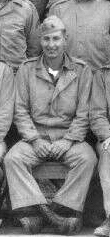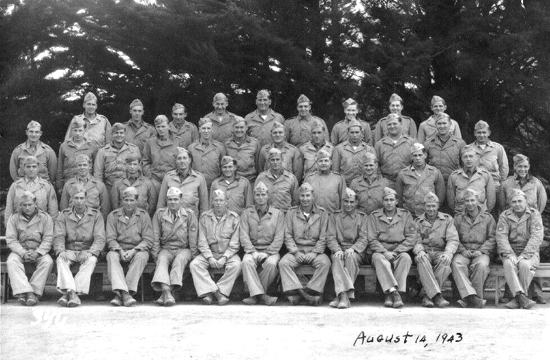Captain Specht was the Commanding Officer of D/1/6 for the Tarawa invasion. His account of the action at Tarawa also includes a section from Hannah's Tarawa: The Toughest Battle in Marine Corps History which Specht comments, "it tells it about like it was". The following information was sent to Vernon C. Bryant as a response to his inquiry about the Japanese counterattack on the third night of the fighting. His father, W. R. Bryant, was also a member of D/1/6 at Tarawa.
Capt. Specht in N. Z.
D/1/6: 20-23 November 1943
1st. Battalion 6th Marines 2nd Division, landed on Betio Island, Tarawa Atoll on the afternoon of the second day.
We made it onto the island intact (2 of the rubber boats were hit). We waded ashore over the coral to Green Beach. The landing craft couldn't negotiate the coral so we switched to the rubber boats and got in. It was dark when we finally got ashore and organized.
The 3rd day our unit, 1st Battalion 6th Marines, attacked along the airstrip. We made good progress until late in the afternoon and dark. Two rifle companies abreast, A company on the left and B company on the right and C company off next to the air strip.
I was CO of the weapons company which consisted of 3 platoons, water cooled 30 caliber machineguns, 81 mm mortar platoon and air cooled 50 caliber machineguns. The machineguns were assigned to the rifle companies and 81mm with battalion HQ (LT Samuel Shaw as platoon leader). Things got tough after dark and so the battalion CO, Wm. K Jones, called me over and asked me to take 81mm platoon as riflemen and some of the headquarters men also as riflemen. We were then about 100-125 yards behind the front lines. I had a guide to lead the way and away we went. I kept shouting loudly to all concerned that we were coming through and to hold your fire.
We arrived at the front lines of two companies and placed our 75-80 men in the lines and then I crawled all along the front line to straighten it up so we couldn't get enfilade fire on each other.
We repulsed the two attacks and I asked for naval gunfire to assist and I observed it and told them they were 100 yards behind us, but the naval gunfire is very accurate and they kept sending in the illumination shells and they exposed the whole area. The "Nips" and our lines were only 45 to 50 yards apart. We could hear them talking (and it sounded) like a bunch of monkeys.
We held out and daylight came. We shoved off on attack but were held up on the right flank by more pillboxes. One Sherman tank was on the airstrip on our left flank and so I ran out to it and led it to our zone and they fired their 75mm and then the 3rd. Battalion 6th marines moved through us and by noon of that day the island was secured.
The 81mm platoon carried about 75 men and they fought very well as riflemen on this occasion.
Earlier on the 3rd day, the battalion surgeon and I and my runner were on our way over to the battalion CP. We came under fire from a pillbox. We laid behind some coconut trees and my runner was hit. In front of me were 2 Japs 15 to 20 yards looking at us. My carbine was jammed. I fired 21 rounds with my 45 pistol and never hit a one.
The following paragraphs are excerpted from Dick Hannah's, Tarawa: The Toughest Battle in Marine Corps History:1
Much of the credit for finishing off the last pocket of Japs went to a mortar platoon headed by Capt. Lyle Specht, Silverton, Oregon. Tribute to the outfit was paid by a regimental commander, Colonel Maurice G. Holmes, Pontotoc, Mississippi, who said the mortar men, "filled a gap in our lines and proved the major factor in turning back the enemy's charge."
The 200 Japs 2 who had been bottled into Betio's tail gathered their remaining strength on the fourth night for one final fanatical charge against two Marine rifle companies which were closing in. Major William K Jones, Joplin, Missouri, said the desperate, last-ditch attack almost split his front line rifle companies, and Captain Specht's outfit was sent in to fill the dangerous breach. The mortar men went in to do their work with fixed bayonets, so serious was the threat. The story of the surprising and desperate charge which follows was told on the fifth morning (November 24) to International News Service correspondent John R. Henry by Captain Specht.
"The Nips opened up at 7:00 p.m. and again at 11:00, and shortly before 4:00 o'clock this morning they tried to rush us again," said the captain. "We pitched everything we had at them and when the melee of grenade-throwing, machine-gunning and bayoneting was finished, we moved forward across piles of dead Japs. In some spots, the bodies were four and five deep."
"Captain Specht's mortar outfit additionally reinforced the rifle companies which withstood the brunt of the Jap attack and refused to give ground even though heavy casualties were suffered by the time the mortar outfit arrived."
"The first counterattack came at 1930. A force of fifty Japanese infiltrated past Jones' outposts in the thick vegetation and penetrated the boundry between the two companies south of the airstrip. Jones' reserve force, composed of 'my mortar platoon and my headquarters cooks and bakers and admin people,' contained the penetration and killed the enemy in two hours of close-in fighting under the leadership of Capt. Lyle "Spook" Specht, commanding the Weapons Company. 'The lines became badly mishapen,' Specht reminisced. 'I crawled all night getting them back in order." Specht also helped call and adjust the star shells from the destroyers USS Sigsbee and USS Schroeder.3
Within fifteen minutes of the initial action, at 1945, Capt Specht, the Weapons Company exec, moved forward with the battalion reserve of 81 mm mortar crewmen to mop up. The gunners unsheathed bayonets and went to work against the almost invisible infiltrators, hand to hand. They and several headquarters warriors who joined them literally pried the Japanese from hiding places across the infiltrated area. 4

Marines of mortar platoon from D/1/6. For more
information on this unit follow the link.

Officers of D/1/6. Capt. Specht is second from the right on the first row.
Notes
1.Dick Hannah, Tarawa: The Toughest Battle in Marine Corps History, 1944, p. 50-51.
2. While the exact number is unknown there were many more than 200 Japanese remaining alive on Betio for the Banzai attack. Just in front of the Marine positions 125 Japanese bodies were found and 75 yards further more then 200 bodies littered the cratered landscape. Lt. Ota estimated 750 Japanese including himself were invovled in the attack. See Alexander, p. 201-202.
3. Alexander, p. 199.
4. Hammel and Lane, p. 250.
Send an Email:
copyright 2001 T.O.T.W.
Created 16 August - Updated 21 February 2005

Return to Index